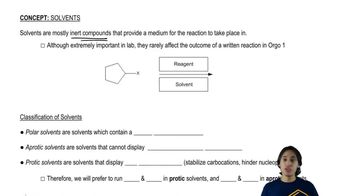SN1 substitution and E1 elimination frequently compete in the same reaction.
b. Compare the function of the solvent (methanol) in the E1 and SN1 reactions.

 Verified step by step guidance
Verified step by step guidance Verified video answer for a similar problem:
Verified video answer for a similar problem:



 6:21m
6:21mMaster Understanding the difference between basicity and nucleophilicity. with a bite sized video explanation from Johnny
Start learning